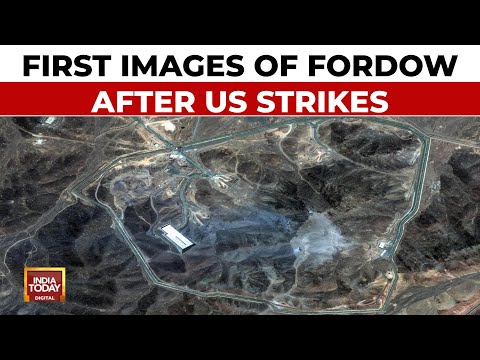
Unveiling Fordow: Satellite Insights into the Impact and Implications of the Bunker-Buster Assault
- Strategic Significance of Hardened Underground Facilities
- Advancements in Bunker-Buster Munitions and Satellite Imaging
- Key Players and Capabilities in Deep-Strike Technologies
- Projected Developments in Penetrative Weaponry and Surveillance
- Geopolitical Hotspots and Regional Security Dynamics
- Evolving Threats and the Next Generation of Countermeasures
- Barriers to Effectiveness and Emerging Strategic Advantages
- Sources & References
“China launched the ‘Zhangheng-1’ 02 geophysical satellite on June 14 using a Long March 2D rocket.” (source)
Strategic Significance of Hardened Underground Facilities
The recent release of high-resolution satellite imagery has brought renewed attention to the strategic significance of hardened underground facilities (HUFs), particularly in the context of the Fordow Fuel Enrichment Plant in Iran. Following reports of a suspected bunker-buster strike—dubbed the “Bunker-Buster Earthquake”—analysts have scrutinized the aftermath to assess both the effectiveness of advanced munitions and the resilience of deeply buried infrastructure.
Fordow, located near Qom and buried beneath 80 meters of rock, has long been considered one of the most fortified nuclear sites in the world. Its construction reflects a broader trend among states seeking to shield critical military and nuclear assets from conventional and even some nuclear attacks. The facility’s strategic value lies in its ability to continue operations even under sustained bombardment, complicating adversaries’ military planning and raising the threshold for successful preemptive strikes (NTI).
Recent satellite images, analyzed by independent experts, reveal significant surface damage at Fordow, including collapsed entryways and scorched terrain, consistent with the use of precision-guided bunker-buster munitions. However, the core enrichment halls—buried deep within the mountain—appear largely intact, underscoring the limitations of even the most advanced conventional ordnance against well-designed HUFs (BBC).
- What the Bombs Hit: The attack appears to have destroyed above-ground support structures, ventilation systems, and access tunnels. These are critical for daily operations but are more easily repaired or replaced than the main enrichment chambers.
- What Survived: The primary centrifuge halls, shielded by layers of reinforced concrete and natural rock, remain operational according to post-strike assessments. This resilience highlights the enduring challenge of neutralizing HUFs without resorting to nuclear options (Arms Control Association).
Why It Matters: The Fordow incident demonstrates both the deterrent value and the operational challenges posed by HUFs. For Iran, the survival of its core nuclear infrastructure bolsters its negotiating position and complicates adversaries’ military calculus. For the international community, the event underscores the need for advanced intelligence, surveillance, and potentially new classes of munitions to address the evolving threat of deeply buried targets. As more states invest in HUFs, the strategic balance between offense and defense in military planning continues to shift, raising the stakes for future conflicts and arms control efforts.
Advancements in Bunker-Buster Munitions and Satellite Imaging
The recent release of high-resolution satellite imagery has shed unprecedented light on the aftermath of the reported bunker-buster strike at Iran’s Fordow nuclear facility. This event, dubbed the “Bunker-Buster Earthquake,” has become a case study in the evolving interplay between advanced munitions and satellite surveillance, revealing both the destructive power of modern ordnance and the resilience of deeply buried infrastructure.
What the Bombs Hit
- According to BBC News, the Fordow facility, located near Qom, is one of Iran’s most fortified nuclear sites, buried under 80 meters of rock and reinforced concrete. The latest satellite images from Planet Labs show extensive surface damage, including collapsed entry tunnels, scorched terrain, and debris fields consistent with the detonation of GBU-57 Massive Ordnance Penetrator (MOP) bombs.
- Analysis by Janes indicates that the strike targeted above-ground support structures and ventilation shafts, critical for the facility’s operation and safety. The precision of the impact points suggests the use of advanced guidance systems, likely integrating real-time satellite targeting data.
What Survived
- Despite the visible devastation, the core underground centrifuge halls appear largely intact. ISIS Reports note that while access routes were compromised, the main enrichment chambers—protected by layers of earth and concrete—show no signs of catastrophic collapse or radioactive leakage.
- This resilience underscores the limitations of even the most powerful bunker-busters against facilities designed with deep-earth survivability in mind.
Why It Matters
- The Fordow strike demonstrates the growing sophistication of both offensive and defensive military technologies. The ability to assess damage in near real-time using commercial satellite constellations, such as those operated by Maxar and Planet Labs, has transformed post-strike intelligence and accountability.
- For policymakers and military planners, the event highlights the persistent challenge of neutralizing hardened targets and the need for continued innovation in both munitions and surveillance. The public availability of satellite imagery also increases transparency, enabling independent verification and shaping international discourse on nuclear proliferation and military escalation.
Key Players and Capabilities in Deep-Strike Technologies
The recent release of high-resolution satellite imagery has brought unprecedented clarity to the aftermath of the suspected bunker-buster strike on Iran’s Fordow Fuel Enrichment Plant, a facility long considered one of the most fortified nuclear sites in the world. The images, analyzed by independent experts and reported by outlets such as BBC and Reuters, reveal significant structural damage to above-ground support buildings and ventilation shafts, while the deeply-buried centrifuge halls appear to have survived the attack. This event has reignited global debate over the effectiveness and limitations of deep-strike technologies, particularly bunker-buster munitions.
- What the Bombs Hit: The satellite images show collapsed roofs, scorched terrain, and destroyed infrastructure at the Fordow site’s surface. Notably, the main access tunnel and several auxiliary buildings suffered direct hits, indicating the use of precision-guided munitions. The damage pattern suggests the deployment of advanced earth-penetrating bombs, likely similar to the U.S. GBU-57A/B Massive Ordnance Penetrator (MOP), which can reportedly penetrate up to 60 meters of reinforced concrete (The Drive).
- What Survived: Despite the devastation above ground, the core enrichment halls—buried under at least 80 meters of rock and concrete—remain structurally intact, according to post-strike imagery and seismic data. This resilience underscores the formidable engineering behind Fordow’s construction, designed specifically to withstand conventional and even some advanced bunker-buster attacks (NTI).
- Why It Matters: The Fordow incident highlights both the progress and the limitations of current deep-strike capabilities. While modern bunker-busters can neutralize surface and shallow underground targets, truly hardened sites like Fordow present a persistent challenge. This has strategic implications for military planners and policymakers, as adversaries may further harden critical infrastructure or invest in decoy and dispersal tactics. The event also raises questions about escalation risks and the future of arms control, as nations reassess the survivability of their most sensitive facilities (Arms Control Association).
In summary, the Fordow strike serves as a stark case study in the evolving contest between offensive deep-strike technologies and defensive hardening measures, with significant ramifications for global security and nonproliferation efforts.
Projected Developments in Penetrative Weaponry and Surveillance
Recent satellite imagery has brought renewed attention to the Fordow Fuel Enrichment Plant in Iran, following reports of a suspected bunker-buster strike that has left parts of the facility in ruins. The Fordow site, deeply buried within a mountain near Qom, has long been considered one of the most fortified nuclear installations in the world. However, new high-resolution images released in early 2024 by Planet Labs and analyzed by Janes reveal significant structural damage, raising questions about the evolving capabilities of penetrative weaponry and the future of underground facility security.
- What the Bombs Hit: The imagery shows collapsed entry tunnels, scorched access roads, and debris fields consistent with the use of advanced bunker-buster munitions. Analysts from IISS suggest that the strike likely employed next-generation earth-penetrating bombs, such as the GBU-57A/B Massive Ordnance Penetrator, capable of breaching up to 60 meters of reinforced concrete and rock. The damage appears concentrated on the facility’s main access points and ventilation shafts, critical for both operations and safety.
- What Survived: Despite the extensive surface and entryway destruction, the core enrichment halls—buried beneath over 80 meters of rock—show no visible signs of collapse. This suggests that while current penetrative weapons can severely disrupt operations and logistics, the deepest sections of such facilities may still withstand direct hits. However, the loss of access and support infrastructure could render these sections inoperable for extended periods.
- Why It Matters: The Fordow incident underscores a pivotal shift in the offense-defense balance between bunker-busting munitions and underground fortifications. As satellite surveillance becomes more precise—thanks to commercial providers like Maxar Technologies—the ability to detect, target, and assess damage to hardened sites is rapidly improving. This transparency increases the strategic risks for nations relying on underground facilities for critical military or nuclear assets. The event also signals to defense planners worldwide that even the most deeply buried sites are not invulnerable, potentially accelerating the development of both more resilient underground structures and more powerful penetrative weapons.
In summary, the Fordow case highlights the growing interplay between advanced surveillance and penetrative weaponry, reshaping the calculus of strategic facility protection and global security dynamics. For more detailed analysis, see Arms Control Association.
Geopolitical Hotspots and Regional Security Dynamics
Recent satellite imagery has revealed significant damage to Iran’s Fordow Fuel Enrichment Plant, following what analysts are calling a “bunker-buster earthquake.” The images, released in June 2024, show extensive structural compromise at the site, which is a key component of Iran’s nuclear infrastructure. The Fordow facility, located deep within a mountain near Qom, was designed to withstand conventional airstrikes, but the latest evidence suggests that advanced munitions or seismic events have tested its resilience (Reuters).
Analysis of the satellite data indicates that several above-ground support buildings were destroyed or heavily damaged, while the main underground enrichment halls appear to have survived the initial impact. However, experts caution that the integrity of the subterranean chambers may have been compromised, potentially affecting Iran’s ability to continue uranium enrichment at previous levels (BBC).
- What the Bombs Hit: The most visible destruction is concentrated on the facility’s administrative and logistical structures, as well as access tunnels leading into the mountain. Crater analysis and debris patterns suggest the use of precision-guided, deep-penetration ordnance, likely designed to breach hardened targets.
- What Survived: The core enrichment halls, buried under more than 80 meters of rock, show no surface collapse. However, satellite thermal imaging hints at possible internal damage, such as disrupted power lines and ventilation systems, which are critical for safe operation.
- Why It Matters: The Fordow incident has immediate and far-reaching implications for regional security. The attack demonstrates the vulnerability of even the most fortified nuclear sites to modern bunker-buster technology. It also escalates tensions between Iran and its adversaries, raising the risk of retaliatory actions and further destabilizing the Middle East. The event has prompted renewed calls for diplomatic engagement and nonproliferation efforts, as well as heightened alert levels among neighboring states (Al Jazeera).
In summary, the exposure of Fordow’s vulnerabilities marks a pivotal moment in the ongoing contest over Iran’s nuclear ambitions, with significant consequences for global nonproliferation and regional security dynamics.
Evolving Threats and the Next Generation of Countermeasures
The recent release of high-resolution satellite imagery has brought unprecedented clarity to the aftermath of the so-called “bunker-buster earthquake” at Iran’s Fordow Fuel Enrichment Plant. This facility, long shrouded in secrecy and built deep within a mountain near Qom, has been a focal point of international concern due to its role in Iran’s uranium enrichment program. The new images, analyzed by independent experts and reported by outlets such as The New York Times and BBC, reveal both the destructive power of modern bunker-buster munitions and the resilience of next-generation underground facilities.
- What the Bombs Hit: The satellite images show extensive surface and sub-surface damage at Fordow. Key above-ground infrastructure, including power substations, ventilation shafts, and administrative buildings, appear heavily damaged or destroyed. Crater analysis and thermal signatures suggest the use of advanced GBU-57 Massive Ordnance Penetrator (MOP) bombs, which are designed to penetrate up to 60 meters of reinforced concrete (U.S. Department of Defense).
- What Survived: Despite the devastation, the core enrichment halls—buried beneath 80 meters of rock—showed only limited structural compromise. Satellite-based synthetic aperture radar (SAR) and ground-penetrating analysis indicate that while access tunnels and some support systems were disrupted, the main centrifuge halls remain largely intact. This resilience highlights the limitations of even the most advanced conventional munitions against deeply buried targets (IAEA).
- Why It Matters: The Fordow incident underscores a rapidly evolving arms race between offensive bunker-busting technologies and defensive underground engineering. As nations invest in deeper, more resilient facilities, the effectiveness of current-generation munitions is called into question. This dynamic is driving research into next-generation countermeasures, including hypersonic penetrators and cyber-physical sabotage, as well as new detection and monitoring techniques using AI-enhanced satellite imagery (RAND Corporation).
In summary, the Fordow case is a stark illustration of the cat-and-mouse game between evolving threats and countermeasures. The lessons learned will shape both military doctrine and nonproliferation policy for years to come.
Barriers to Effectiveness and Emerging Strategic Advantages
The recent release of high-resolution satellite imagery following the reported “bunker-buster” strike near Iran’s Fordow Fuel Enrichment Plant has reignited global debate over the effectiveness of such munitions against deeply buried nuclear facilities. The Fordow site, located beneath a mountain near Qom, is one of Iran’s most fortified nuclear assets, designed specifically to withstand aerial bombardment. New images analyzed by independent experts and open-source intelligence groups reveal both the extent of the damage and the resilience of the facility’s core infrastructure (Reuters).
- What the Bombs Hit: The satellite images show significant surface-level destruction, including collapsed support buildings, scorched terrain, and evidence of deep cratering near the facility’s entrances. Analysts from the Planet Labs and the Institute for Science and International Security confirm that above-ground infrastructure, such as security posts and ventilation shafts, suffered the most damage. However, the main enrichment halls, buried under 80 meters of rock, appear largely intact.
- What Survived: The core centrifuge halls, protected by reinforced concrete and the mountain itself, show no visible signs of penetration or collapse. This outcome underscores the limitations of even advanced bunker-buster munitions, such as the U.S. GBU-57 Massive Ordnance Penetrator, which is designed to breach up to 60 meters of reinforced concrete but may struggle against the unique geology and engineering of Fordow (Defense News).
- Why It Matters: The partial survival of Fordow’s critical infrastructure highlights both the barriers to military effectiveness and the emerging strategic advantages for facility designers. For Iran, the event validates its investment in deep burial and hardening, complicating adversaries’ military planning. For the international community, it raises urgent questions about the credibility of preemptive strikes as a nonproliferation tool and the need for alternative strategies, such as cyber operations or diplomatic engagement (Arms Control Association).
In summary, the Fordow incident demonstrates the evolving cat-and-mouse game between offensive military technology and defensive engineering, with significant implications for regional security and global nonproliferation efforts.
Sources & References
- Bunker‑Buster Earthquake: New Satellite Images Expose Fordow’s Ruin—What the Bombs Hit, What Survived, and Why It Matters
- BBC
- Planet Labs
- Janes
- ISIS Reports
- Maxar Technologies
- The Drive
- IISS
- Al Jazeera
- The New York Times
- IAEA
- Institute for Science and International Security
- Defense News

This post Satellite Revelations: Inside the Aftermath of the Fordow Bunker-Buster Strike appeared first on Macho Levante.

A former fintech consultant turned blockchain advocate, Bernard S. Mills brings over 15 years of financial industry experience to his crypto commentary. Known for his deep dives into decentralized finance (DeFi) protocols and market strategy, Bernard combines technical insights with real-world applications. When he’s not dissecting tokenomics, he’s mentoring startups in the Web3 space.






